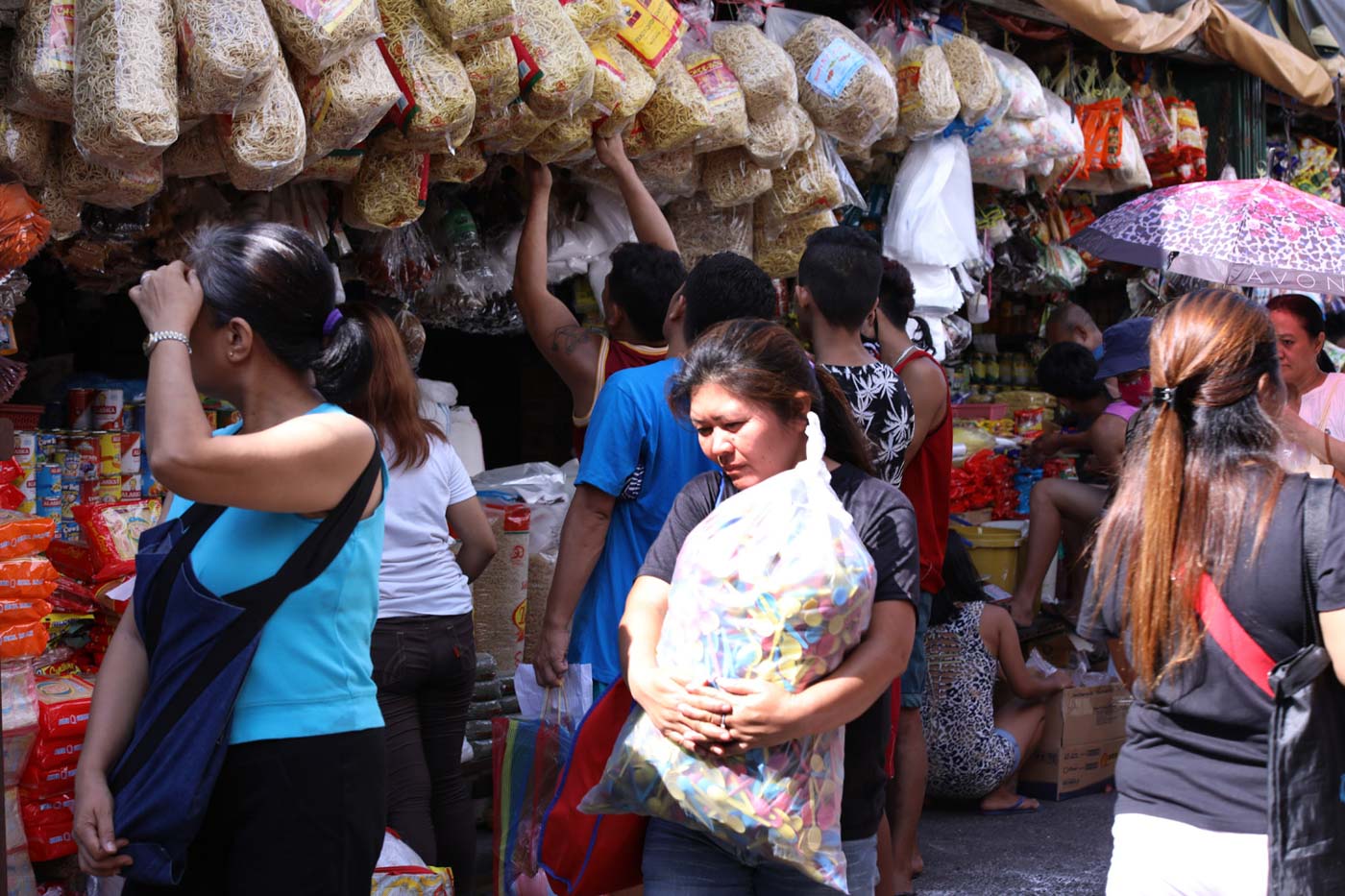
MANILA, Philippines – The poorest or bottom 30% income households felt inflation at 8% in August 2018, according to the latest release from the Philippine Statistics Authority (PSA).
The figure was higher than the 7.3% recorded in July 2018 and the 3% posted in August 2017. (READ: EXPLAINER: How inflation affects you)
{source}
<iframe id="datawrapper-chart-wcMTh" src="//datawrapper.dwcdn.net/wcMTh/1/" scrolling="no" frameborder="0" allowtransparency="true" style="width: 0; min-width: 100% !important;" height="400"></iframe><script type="text/javascript">if("undefined"==typeof window.datawrapper)window.datawrapper={};window.datawrapper["wcMTh"]={},window.datawrapper["wcMTh"].embedDeltas={"100":504,"200":426,"300":426,"400":400,"500":400,"700":400,"800":400,"900":400,"1000":400},window.datawrapper["wcMTh"].iframe=document.getElementById("datawrapper-chart-wcMTh"),window.datawrapper["wcMTh"].iframe.style.height=window.datawrapper["wcMTh"].embedDeltas[Math.min(1e3,Math.max(100*Math.floor(window.datawrapper["wcMTh"].iframe.offsetWidth/100),100))]+"px",window.addEventListener("message",function(a){if("undefined"!=typeof a.data["datawrapper-height"])for(var b in a.data["datawrapper-height"])if("wcMTh"==b)window.datawrapper["wcMTh"].iframe.style.height=a.data["datawrapper-height"][b]+"px"});</script>
{/source}
All indices of all the commodity groups posted higher annual rates during August, except for fuel, electricity, and water.
Food inflation picked up by 7.8% in August, much higher than the 6.9% in July and the 3% posted during the same month in 2017. (READ: [ANALYSIS] Why is Philippine inflation now the highest in ASEAN?)
The PSA also reported higher annual markups in all food groups, except for corn which registered a slower annual hike of 3%.
{source}
<iframe id="datawrapper-chart-XVdzw" src="//datawrapper.dwcdn.net/XVdzw/1/" scrolling="no" frameborder="0" allowtransparency="true" style="width: 0; min-width: 100% !important;" height="400"></iframe><script type="text/javascript">if("undefined"==typeof window.datawrapper)window.datawrapper={};window.datawrapper["XVdzw"]={},window.datawrapper["XVdzw"].embedDeltas={"100":518,"200":417,"300":417,"400":400,"500":400,"700":400,"800":400,"900":400,"1000":400},window.datawrapper["XVdzw"].iframe=document.getElementById("datawrapper-chart-XVdzw"),window.datawrapper["XVdzw"].iframe.style.height=window.datawrapper["XVdzw"].embedDeltas[Math.min(1e3,Math.max(100*Math.floor(window.datawrapper["XVdzw"].iframe.offsetWidth/100),100))]+"px",window.addEventListener("message",function(a){if("undefined"!=typeof a.data["datawrapper-height"])for(var b in a.data["datawrapper-height"])if("XVdzw"==b)window.datawrapper["XVdzw"].iframe.style.height=a.data["datawrapper-height"][b]+"px"});</script>
{/source}
The figure was computed by adjusting the weights of commodity groups in the consumer price index (CPI) to reflect the typical budget of the poorest Filipino households.
Headline inflation, the figure regularly reported by the media and the PSA, was at 6.4% in August. It rose to 6.7% in September.
Poorer Filipinos in regions
The poorest households in the National Capital Region (NCR) felt inflation at 8.3%, higher than the 4.7% recorded in August 2017.
Food and non-alcoholic beverages as well as tobacco prices contributed most to the spike.
Inflation in areas outside NCR picked up by 8%, higher than the 3% recorded in the same month last year.
{source}
<iframe id="datawrapper-chart-9g3fl" src="//datawrapper.dwcdn.net/9g3fl/1/" scrolling="no" frameborder="0" allowtransparency="true" style="width: 0; min-width: 100% !important;" height="400"></iframe><script type="text/javascript">if("undefined"==typeof window.datawrapper)window.datawrapper={};window.datawrapper["9g3fl"]={},window.datawrapper["9g3fl"].embedDeltas={"100":529,"200":443,"300":426,"400":400,"500":400,"700":400,"800":400,"900":400,"1000":400},window.datawrapper["9g3fl"].iframe=document.getElementById("datawrapper-chart-9g3fl"),window.datawrapper["9g3fl"].iframe.style.height=window.datawrapper["9g3fl"].embedDeltas[Math.min(1e3,Math.max(100*Math.floor(window.datawrapper["9g3fl"].iframe.offsetWidth/100),100))]+"px",window.addEventListener("message",function(a){if("undefined"!=typeof a.data["datawrapper-height"])for(var b in a.data["datawrapper-height"])if("9g3fl"==b)window.datawrapper["9g3fl"].iframe.style.height=a.data["datawrapper-height"][b]+"px"});</script>
{/source}
Cagayan Valley (11%) and Western Visayas (10.1%) posted double-digit figures.
Stubbornly high inflation forced economic managers to revise the country's outlook.
They previously saw gross domestic product (GDP) reaching 7% to 8%. The upper end of the revised target is now at 6.9%. – Rappler.com